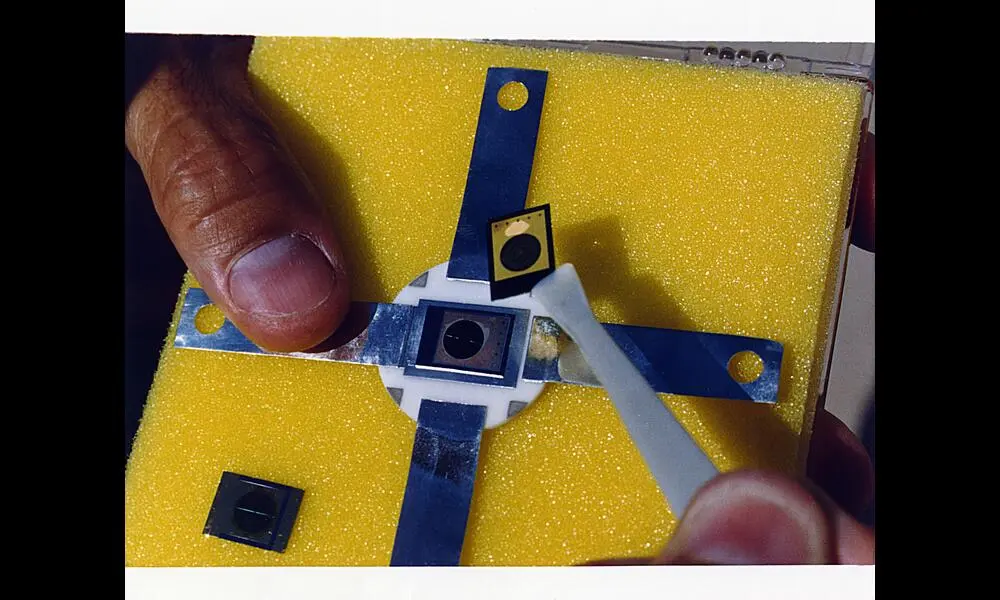New High Temperature Semiconductor Diodes Operate at 600˚C
Published on Wed Mar 06 2024 File:NREL.jpg | LX on Wikimedia
File:NREL.jpg | LX on WikimediaIn an electrifying leap forward for the world of electronics, researchers at the National Renewable Energy Laboratory and the Colorado School of Mines have achieved a milestone that promises to turbocharge the durability and performance of devices operating in extreme conditions. The team has successfully demonstrated that Cr2O3:Mg/ β-Ga2O3 p-n heterojunction diodes can not only survive but thrive at scorching temperatures of up to 600˚C. This breakthrough, detailed in a recent preprint paper, is not just a testament to the robustness of these devices but also a beacon of hope for industries reliant on power electronic devices and sensors that need to operate reliably in harsh environments.
Beta gallium oxide (β-Ga2O3), a semiconductor known for its large bandgap and high breakdown field, has attracted attention for its potential in high-voltage and high-frequency applications. What makes this study stand out is the use of chromium oxide (Cr2O3) doped with magnesium (Mg) to create a p-n heterojunction with β-Ga2O3, marking a significant step away from more commonly explored materials. The Cr2O3:Mg/ β-Ga2O3 p-n diodes showcased not only a high room-temperature rectification ratio of >104 at ±5V but also a breakdown voltage of -390V. Beyond mere performance metrics, these diodes have demonstrated exceptional stability under conditions that would be considered extreme for electronic components, including prolonged exposure to temperatures as high as 600˚C and 30 cycles of thermal shock ranging from 25-550˚C.
This landmark achievement stems not just from the innovative materials used but also from a deep understanding of the chemical and physical interactions at play. Detailed examination of the devices after testing revealed that the observed degradation in electrical performance — such as increased on-state resistance and turn-on voltage — was primarily due to the diffusion of Mg and MgO to the Cr2O3/Ga2O3 interface. Yet, despite these changes, the devices maintained remarkable stability in reverse-bias leakage current, a critical factor for their long-term reliability.
The implications of this study are far-reaching. For one, it propels β-Ga2O3-based devices from being laboratory curiosities to potential workhorses in industries where equipment must function flawlessly in high-temperature conditions, such as in aerospace, automotive, and energy sectors. Moreover, the findings lay a foundation upon which further advancements in ultra-wide bandgap (UWBG) semiconductor technology can be built. By pushing the limits of what's possible, this research not only challenges existing paradigms in semiconductor design but also opens up new avenues for developing devices that can operate under conditions previously deemed too harsh.
As the demand for more robust electronic devices grows, especially with the push towards electrification and renewable energy, the importance of such innovations cannot be overstated. This study not only highlights the potential of Cr2O3:Mg / 𝛽-Ga2O3 p-n heterojunction diodes in high-temperature applications but also underscores the continuous need for exploring new material combinations and device architectures. The quest for devices that can endure extreme conditions is far from over, but with each breakthrough, we edge closer to realizing electronics that can withstand the heat — quite literally.
Keep Reading
New research has identified and addressed the intrinsic impairments that limit the accuracy of temperature measurements in silicon photonic ring resonator thermometers. These impairments arise from changes in the waveguide effective index, as well a...


